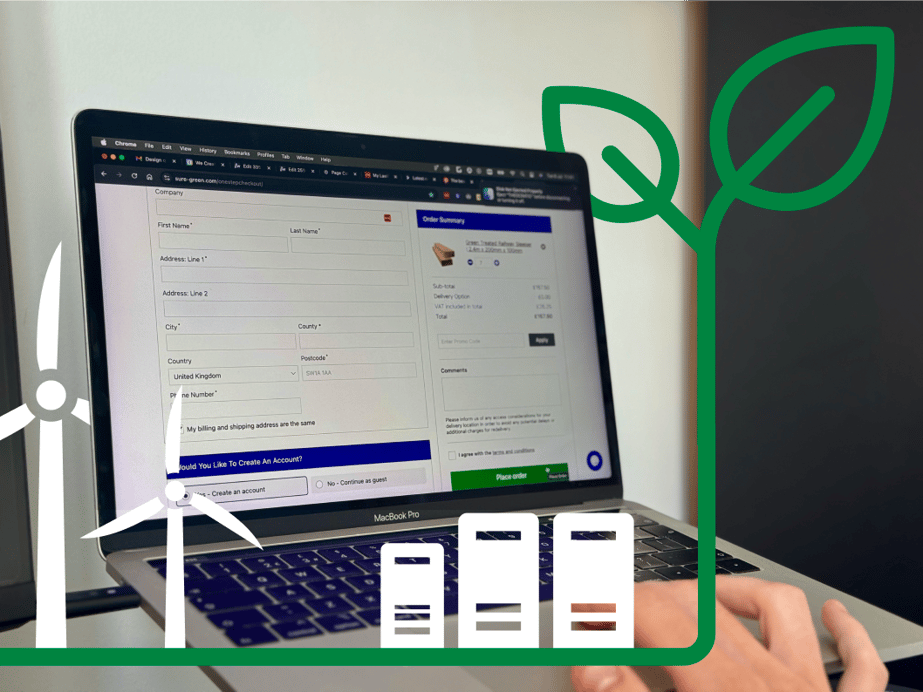The term digital sustainability is new to many people - we dive into what it means, how we apply it to our work, and what should be done by organisations to ensure they're staying on track to achieve their own digital sustainability goals.

What is sustainable web design and development?
A sustainable website is one that is designed and built to minimise the amount of energy needed every time it loads. When someone visits a website, it triggers a chain of activity: data moves from servers through networks to the device in front of them. Every image, video, or line of code adds to that journey – and all of it consumes electricity. The heavier and less efficient a site is, the more energy it demands. That extra energy use translates into a higher carbon footprint.
This is a slightly narrower view within digital sustainability, as of course, websites are just one part of our digital experiences. This takes us to:
What is digital sustainability?
Digital sustainability is a broader term, refers to creating, operating and maintaining digital products or services in ways that minimise their environmental impact. Everything we do online has a cost – loading cookies into browsers, playing videos, or running code all consume energy and resources. Digital sustainability is about considering these costs within our decision-making, firstly by converting these costs into a useful metric and then defining an approach that reduces the impact of this activity at scale.
For us, digital sustainability means managing digital resources responsibly. We aim to clearly understand and limit data transfer wherever possible, without compromising on design or features.
This includes optimising servers and data centres, particularly regarding their energy sources. For example, choosing those that use renewable or clean energy. It also involves reducing a website’s carbon footprint through thoughtful design and feature selection. This could involve efficient coding practices, selectively using lightweight themes or plugins, and optimising content delivery methods.
It also means making deliberate choices with media – using images at appropriate sizes, compressing files effectively, and embedding videos sparingly. Also, rather than autoplaying a large video file, a more sustainable approach might be to embed a link that can be played when the user clicks on it instead. This means the amount of data required, especially at scale and over a large period of time, is greatly reduced. In this case, the device requesting the data, the server sending the data and all the other external parties in-between (such as data centres), all require less energy.
As our reliance on digital technologies increases, so does their energy consumption, carbon footprint and environmental impact.. Therefore, we need to understand the carbon load from digital technologies, and look at how we can address and improve digital sustainability.
Is the internet sustainable?
Over the past few years, there has been more awareness of the fact that the internet, despite being invisible to most users, does have a physical presence that means it has a carbon footprint. However, the scale of this is an unknown for many. They don’t see the data centers, servers and network infrastructure required to power our devices and therefore it is difficult to comprehend how much energy they consume. Yet the internet has a significant environmental impact. It accounts for 3.7% of global carbon emissions each year.
This figure is also likely to be out of date. AI adoption is increasing exponentially and we don’t have transparent data on it to understand its energy consumption. Furthermore, global internet traffic tripled between 2017 and 2022. Any data that is available, quickly becomes out of date and it is tricky to know whether we can assume previous patterns of growth still apply, particularly given AI.
So the question of ‘is the internet sustainable’ seems to have a very concerning answer – no.
Why you need a digital or web sustainability strategy
Digital sustainability also means maintaining what you have done over the long-term. Creating and launching a website or an app that is sustainable is great, but processes need to be followed and checks implemented to ensure it stays this way. For example, for any new page being added to a site, are the images following guidelines set in terms of size limit? Are any plugins being added that haven’t been audited first?
The way to ensure that you remain on track with your digital sustainability goals is to develop a strategy that is carefully implemented and monitored. It sets expectations at all levels, ensuring there is awareness, responsibility and accountability. It allows you to spot any gaps that could risk damaging your digital footprint, such as in training for new team members.
Furthermore, a digital sustainability strategy can have other benefits to your business that go beyond your own internal goals. It can reduce costs through decreased energy usage, enhance your reputation, future-proof your services, and improve overall performance and user experience.
Adopting digital sustainability positions your organisation as responsible and forward-thinking, benefiting both the environment and your long-term business success.
Web sustainability tools
It can be a bit daunting when you are looking into your website and how sustainable it is. The first step will be to benchmark it and to understand a bit more about web sustainability or low-carbon websites. You need data – figures to help you see where you are and where this sits compared to guidelines. While it is helpful seeing how you compare to other organisations, don’t necessarily focus on how much worse or better you are than them – use figures for where you should be as a guide on what your next steps are.
Evaluating the carbon on your website:
Website Carbon – developed by web agency Wholegrain Digital, this was the first tool around to help users look at the carbon load of their website. It explains how much carbon is on the page and gives a percentage of how you compare to web pages globally, as well as a grade. It doesn’t look at the entire website, so if you want an accurate picture of the website as a whole, you have a bit of work to do by looking at either every page, or taking a representative sample of pages and then making calculations based on these pages. Furthermore, calculations for the figures are based on an assumption that a page gets 10,000 views per month.
Ecograder – a tool from another digital agency, Ecograder provides a more detailed summary of a webpage, but again it is just for a page, not the entire website. It gives it a score and states how much carbon is required for the page to load, and then breaks it down to the right showing how it fared within three aspects it analyses: page weight, UX and hosting. Further down, it provides a grade, much like Website Carbon, but it goes further by giving more analytics. It shows how much of the page assets fall into different areas on a pie chart, and provides helpful suggestions for improvements.
Digital Beacon – developed by an agency/consultancy, Beacon has a slick look but it may feel overwhelming compared to the other two examples above. It shows the carbon load from the first visit a user makes to a page but also how much the carbon load is on a return visit, and a gives the page a grade, which has a key towards the bottom of the page to explain how this works. There are also helpful equivalents to understand the figure i.e. the carbon load for one month is equivalent to driving 5.8 miles in a Tesla Model S. It has a helpful emissions calculator where you can add in traffic to get a more accurate picture of the carbon footprint based on page views but also new vs returning users. After these stats, it gets a little more complex with a breakdown of what is on the page and what that contributes to the carbon load, web vitals metrics and ‘opportunities’ for improvement.
If you try more than one tool to analyse a webpage, you’ll notice they don’t all give the same results. Each tool calculates figures in a slightly different way, so there isn’t a single one that’s always higher or lower. Our advice is to work with the highest figure. It’s better to overestimate your website’s carbon load than to underestimate it. A higher result usually signals that there’s still room for improvement, and if you ever need to report on your website’s impact, you’ll avoid the risk of someone else using a stricter tool and finding worse results than you did.
In summary
The internet is a major contributor to co2 emissions each year, and this is growing. While websites are a small part of the digital infrastructure and our global carbon footprint, they’re still an incredibly easy way to help reduce carbon emissions.
By making conscious choices in how we design, build, and host websites, we can cut emissions and create a better experience for users at the same time. Digital sustainability isn’t just about lowering energy use – it’s about showing that your organisation takes responsibility for its impact. Starting with your website is a simple but powerful step towards aligning your digital presence with the values you want to be known for.





